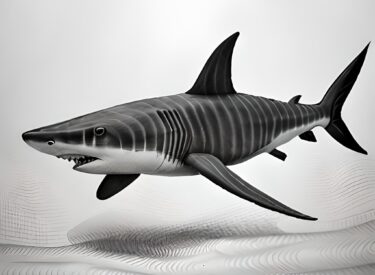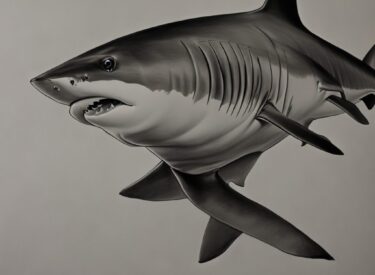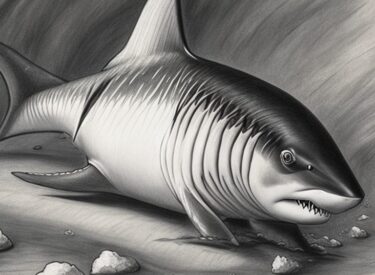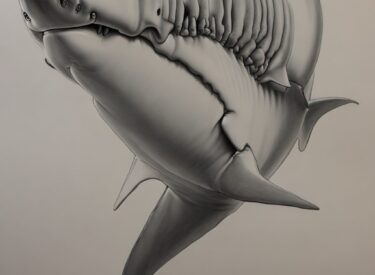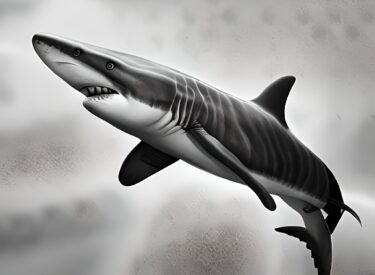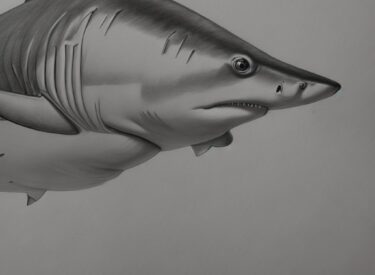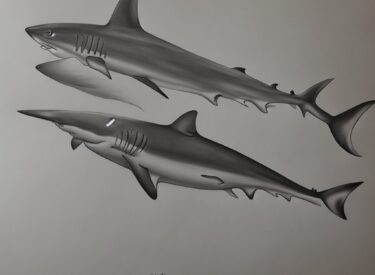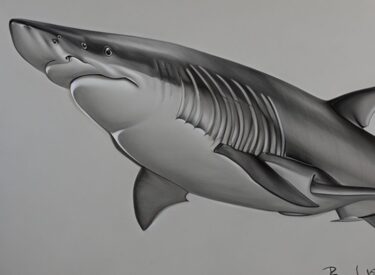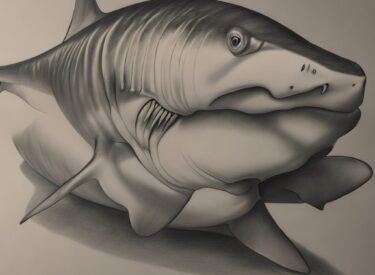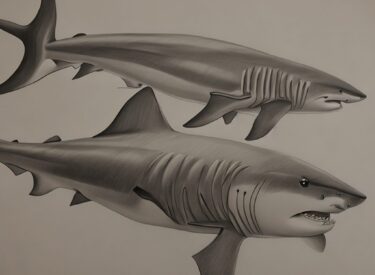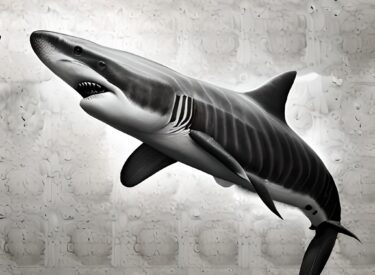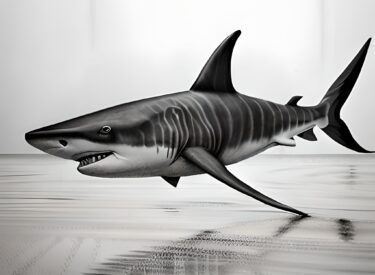Creating realistic pencil shark drawings can be a fun activity for a kid. It can also be a great way to learn about a shark species. If you’ve never done this type of drawing before, you might be surprised by how easy it is to do.
Fins
Whether you want to draw sharks for fun or to illustrate a project, you can use a few simple shapes to get started. You can use a straight line, a curved line, and a slanted line to create a shark body.
Sharks have a dark top and white belly. You can use a curved line to outline their body, then add some dark shading to their eyes. They have five gills on each side. The gills can be added by erasing a small portion of the lateral line before the pectoral fin.
Next, you can draw a shark head. To do this, draw a curved line from the tip of the snout to the bottom of the right side of the shark’s head. Then draw a small back slanted triangle to represent the second dorsal fin.
Sharks also have a mouth. You can draw the mouth with a curved line that starts in the middle of the shark’s head and ends at the top of its head. The teeth can be in a small triangle shape. You can also use a small circle for the eyes and a moon shape for the mouth. You can then finish the mouth by shading the teeth and the mouth.
Once the mouth is complete, you can draw a shark fin. The shark’s fins are in a triangle shape, and the tip will be the outermost point of the fins. You can then draw the fins next to the side of the shark’s body, and then connect them to the end of the shark’s body.
Sharks can also be drawn as they eat. You can add fish, prey, and other creatures to the shark drawing. These can be added to the lateral line, which runs from the snout to the eye.
Body
Whether you’re a beginner or an expert, you can draw sharks by following simple steps. It’s a fun activity for kids, and they will learn about marine animals through the process. It is a great way to enhance their fine motor skills, cognitive development, and artistic talent.
To draw sharks, start with a simple outline. Trace the outline with a pencil. You can use a 4B pencil to do this. You can also use markers to color your shark. You will want to try and blend your drawing until it looks as realistic as possible.
Now that you have an outline, draw a curved line through the center of your shark. This line should be angled upward, towards the left. When you reach the top of your shark’s head, you should draw a small triangle-shaped fin.
This is the shark’s mouth. You can also add eyelashes to the outside ovals. You may want to add more than one layer of teeth.
You’ll also want to draw five gills below the side fin. Your shark’s head should be flattened, and your drawing should also be curved to add some dimension. Your shark should have a small dot for its eye.
The next step is to add shading to the shark’s head and bottom. This should include light shading under the fins, medium shading for the nostrils, and dark shading in the eyes.
Lastly, you can draw a tail, which is a classic shark shape. Your shark’s tail should be curved, and you should draw it a little bit to the left.
You can also draw a shark tail using a simple triangle shape. This will give you a similar effect to your shark’s mouth, and it’s a great way to practice patterns.
Texture
Adding texture to your pencil drawing can add a lot of visual interest to your artwork. The type of texture you choose depends on what kind of effect you’re trying to achieve. For instance, a very fine texture can create a very delicate look, while a coarse texture can give your drawing a bolder appearance.
Adding the proper texture to your drawings can be done using a variety of tools. A few options include using oil paint, oil pastels, sharpened pencils, and various textures.
There are a number of different techniques you can use to create texture, but the most important is the direction you make your marks. A smooth texture can be achieved with blending tools, while a rough texture can be achieved with sharpened pencils. You can also create a texture using acrylic paint.
Creating the best possible texture for your shark drawing is a matter of experimenting with the different techniques. The best way to determine which technique is best is to do some practice sketches before you start. For instance, try blending in a few lines to determine what type of texture you want to create. You can also experiment with different sharpness levels.
The best way to determine the best possible texture for your shark drawing is to determine what kind of effect you’re trying to create. For instance, a rough texture can be achieved with sharpened graphite pencils, while a smooth texture can be achieved with blending tools. You can also experiment with different textures by using various techniques such as scribbling and hatching.
The best possible texture for your shark drawing is based on a combination of these techniques.
Adding color
Adding color to shark pencil drawings will help create the illusion of realism. It is a good idea to add darker shades of color to shadows and lighter shades to highlights to create a more realistic image. You can also add texture to your drawings.
There are many shark species, so you will need to determine which type of shark you want to draw. This can be done by looking online or in a reference book. You will also need to make sure your drawing has the right fins and gills.
Sharks are large, powerful animals. They can be found in the ocean and can appear in several colors, including blue, brown, and grey. You can use your favorite pen, hatching techniques, or stippling techniques to draw them. If you are new to drawing, you can follow a simple tutorial that will help you draw a realistic shark.
Start with an outline of your shark. The outlines will include the head, eye, nose, mouth, and dorsal fin. You should also use the cross-hatches to create shape and lighting.
Once you have finished the outlines, draw the shark’s body. You want to create the outline as a long line, with segmented shapes. You should then use EverBlend markers to color the shark. You will need to create more detailed lines in the body to create realistic shapes.
Next, draw a small triangle under the eye. You should also draw a lateral line that goes from the snout to the eye. This line helps to create movement and gives the shark a more realistic appearance.
Finally, fill in the shark’s tail. You can use a slanting triangle to draw the pectoral fin. The end of the tail should be slightly narrower than the beginning.
Hammerhead sharks
Besides being one of the most impressive creatures in the sea, sharks are also highly regarded by humans. For many, sharks are the epitome of majesty and mystery. They are omnivorous creatures that eat lobster, squid, stingrays, and even bony fishes. They are highly favored by children and adults alike. It’s no wonder they are the poster child for conservation.
Hammerhead sharks are a species that’s not to be taken lightly. They can weigh up to a thousand pounds and live for about twenty to thirty years in the wild. They are also known to hunt by themselves, rather than in groups of predatory sharks called “schools.” They are found in warm tropical waters all over the world, including the Caribbean, Pacific, and Indian oceans. Hammerheads are highly intelligent and can sense their prey in the dark.
In addition to being one of the largest sharks on earth, the hammerhead boasts one of the longest life spans of any fish in the sea. They also swim by moving their head from side to side. They do not often dive below the surface. They are most often seen in surface waters, where they can be spotted in groups of ten to twenty. They are also the most numerous shark species in the world. The most common species is the bonnethead shark, but there are two species in existence. The great hammerhead shark is endangered, while the small bonnethead shark is not.
The most impressive of these is the Great Hammerhead shark, a large specimen of which is currently on exhibit at the Omaha Aquarium in Nebraska. This particular specimen is a great example of how a small species can flourish and become a big threat.


